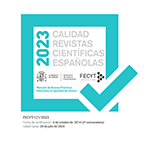Fontcuberta, Humorist and World-builder: How to Create a Mocking Alternative Planisphere (MAP)
Abstract
In the era of post-truth politics, fake news and deepfake (specific digital counterfeit of visual documents) it becomes more necessary than ever to claim the commitment to the truth of those who provides us with information. However, we must also ensure the preservation of a space for fiction that won’t be stigmatized, that won’t be confused with those crude forgeries. Artistic fictions are delicate, fragile matters. On the one hand, they have to maintain their unrestricted ability to imagine alternative worlds that we would like to visit (or on the contrary, we would fear or hate). But on the other, and without contradiction, they must be able to intervene on the real, to reveal by means of metaphors or irony the spirit of time in all its contradictions. The following text analyzes the work of an exceptional creator of worlds through images, Joan Fontcuberta, with the premise that each of its collections is the partial but methodical construction of a universe. In almost forty years of incessant creation (and reflection on it) he has shaped perfectly furnished ironic little worlds: fauna, flora, fossils, aerolites, constellations, geographic features, ethnography, newscast, newspapers and experts, astronauts and miracles, scientists and terrorists, works of art and artists, included art history and museum institutions, all feigned. The sum of these portions constitutes a harmonious whole, a Mocking Alternative Planisphere (MAP), a cartography as complete and demanding in its internal coherence as those reflected by the Borgian Encyclopedia of Tlön, or Tolkien’s or George R. Martin’s fictions.
Downloads
Article download
License
In order to support the global exchange of knowledge, the journal Arte, Individuo y Sociedad is allowing unrestricted access to its content as from its publication in this electronic edition, and as such it is an open-access journal. The originals published in this journal are the property of the Complutense University of Madrid and any reproduction thereof in full or in part must cite the source. All content is distributed under a Creative Commons Attribution 4.0 use and distribution licence (CC BY 4.0). This circumstance must be expressly stated in these terms where necessary. You can view the summary and the complete legal text of the licence.










